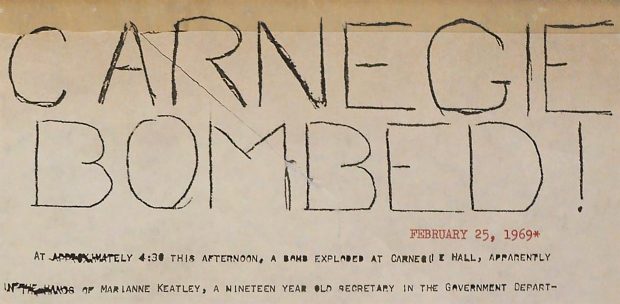
Special hand-headlined TSL after the Carnegie bombing in 1969
Tidmarsh: “… The bomb was placed in Government Professor Lee [’48] McDonald’s mailbox, which led some to question whether the bomber was targeting him directly. Claire McDonald, Lee’s wife and a Pomona alum from 1947, remembers how scary of a time it was for them.”
Claire McDonald: “Lee called me and said there was bombing going on at his office, and I was to be careful and stay in the house. And the kids were to stay in the house. So we were immediately scared. And I called up my daughter, and she and her husband joined us, and we had a very bad night. Every car that went by, we wondered if they were going to throw a bomb at us.”
Tidmarsh: “Professor McDonald was known on campus for being an opponent of the Vietnam War and an ally for the student protesters. However, Professor McDonald was told by law enforcement, and believes to this day, that it was completely random that the bomb was placed in his mailbox. He told us that the bomb wasn’t addressed to him in particular.”
Lee McDonald: “The mail, all the faculty mailboxes were adjacent to the staircase that goes from the lobby of Carnegie down to the first floor. And the mail is usually delivered in the morning. Our secretary for what was then the Government Department just happened to be coming up the stairs in the—guess it was around four o’clock. I’m not exactly sure of the hour. And she saw this shoebox, wrapped in brown paper, in my mailbox. It was a good question, why it was in my mailbox, but I think the ultimate conclusion of everybody was that if a person was running up the stairs, or in a hurry up the stairs, this was the box on the bottom level of all of the boxes and right in the middle. And that would have been the easiest place to quickly place the bomb.”
Desai: “About 40 seconds before the bombing in Carnegie, an identical bomb exploded in a women’s bathroom in the basement of Scripps College’s Balch Auditorium. While no one was injured, the windows were blown out, and the building needed a lot of repairs.”
Lee McDonald: “I also remember that it was Tom Brokaw, who was a pretty well-known NBC reporter for the rest of his life—[he] was a local reporter for the local NBC station in Los Angeles, and he came out and interviewed me. We stood in the Quad.”
Desai: “It’s worth noting that Pomona and Scripps weren’t the only colleges that this happened to. In the late ’60s and early ’70s, college campuses across the nation were bombed. Just in California, San Francisco State University and Southwest College were bombed within a couple of weeks of the Claremont bombing. In 1970, a bomb at the University of Wisconsin, Madison, killed a physics professor and injured three others. The Department of Commerce and the Portland, Ore., City Hall were also bombed. While some remain unsolved, most of the bombings that were prosecuted were tied to statements against the war in Vietnam.”
Tidmarsh: “At Pomona College and across the nation, protests erupted over the Vietnam War and racial justice. It was a tense and tumultuous time that disrupted the status quo in idyllic Claremont. …”
This entire episode is available for download at soundcloud.com, iTunes or Google Play.
